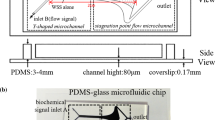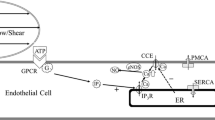Abstract
A new dynamic model for cell-deformation-induced adenosine triphosphate (ATP) release from vascular endothelial cells (VECs) is proposed in this paper to quantify the relationship between the ATP concentration at the surface of VECs and blood flow-induced shear stress. The simulation results demonstrate that ATP concentration at the surface of VECs predicted by the proposed new dynamic model is more consistent with the experimental observations than those by the existing static and dynamic models. Furthermore, it is the first time that a proportional-integral-derivative (PID) feedback controller is applied to modulate extracellular ATP concentration. Three types of desired ATP concentration profiles including constant, square wave and sinusoid are obtained by regulating the wall shear stress under this PID control. The systematic methodology utilized in this paper to model and control ATP release from VECs via adjusting external stimulus opens up a new scenario where quantitative investigations into the underlying mechanisms for many biochemical phenomena can be carried out for the sake of controlling specific cellular events.
Similar content being viewed by others
References
B. S. Khakh, R. A. North. P2X receptors as cell-surface ATP sensors in health and disease[J]. Nature, 2006, 442(3): 527–532.
P. Bodin, G. Burnstock. Purinergic signalling: ATP release[J]. Neurochemical Research, 2001, 26(8/9): 959–969.
P. Bodin, B. J. Bailey, G. Burnstock. Increased flow-induced ATP release from isolated vascular endothelial but not smooth muscle cells[J]. British Journal of Pharmacology, 1991, 103: 1203–1205.
P. Milner, P. Bodin, A. Loesch, et al. Increased shear-stress leads to differential release of endothelin and atp from isolated endothelialcells from 4-month-old and 12-month-old male rabbit aorta[J]. Journal of Vascular Research, 1992, 29(6): 420–425.
V. Ralevic, G. Burnstock. Receptors for purines and pyrimidines[J]. Pharmacological Reviews, 1998, 50(3): 413–492.
K. Yamamoto, T. Sokabe, N. Ohura, et al. Endogenously released ATP mediates shear stress-induced Ca2+ influx into pulmonary artery endothelial cells[J]. American Journal of Physiology-heart and Circulatory Physiology, 2003, 285(2): H793–H803.
K. John, A. I. Barakat. Modulation of ATP/ADP concentration at the endothelial surface by shear stress: effect of flow-induced ATP release[J]. Annals of Biomedical Engineering, 2001, 29(9): 740–751.
M. K. Uchida (Eds). Receptor Desensitization and Ca 2+ Signaling: Cellular Aspects of Possible Molecular Dynamics[M]. Basel, Switzerland: S. Karger AG, 1996.
K. Qin, C. Xiang, Z. Xu, et al. Dynamic modeling for shear stress induced ATP release from vascular endothelial cells[J]. Biomechan Model Mechanobiol, 2008, 7(5): 345–353.
J. D. Wan, W. D. Ristenpart, H. A. Stone. Dynamics of shear-induced ATP release from red blood cells[J]. Proceedings of the National Academy of Sciences of the United States of America, 2008, 105(43): 16432–16437.
J. R. Womersley. Method for the calculation of velocity, rate of flow and viscous drag in arteries when the pressure gradient is known[J]. Journal of Physiology, 1955, 127(3): 553–563.
A. I. Barakat. A model for shear stress-induced deformation of a flow sensor on the surface of vascular endothelial cells[J]. Journal of Theoretical Biology, 2001, 210(2): 221–236.
Y. C. Fung. Biomechanics: Mechanical Properties of Living Tissues[M]. New York: Springer-Verlag, 1981.
J. Ando, T. Komatsuda, A. Kamiya. Cytoplasmic calcium response to fluid shear stress in cultured vascular endothelial cells[J]. In Vitro Cellular & Developmental Biology, 1988, 24(9): 871–877.
J. Ando, A. Ohtsuka, R. Korenaga, et al. Effect of extracellular ATP level on flow-induced Ca2+ response in cultured vascular endothelial cells[J]. Biochemical and Biophysical Research Communications, 1991, 179(3): 1192–1199.
P. Bodin, G. Burnstock. Evidence that release of adenosine triphosphate from endothelial cells during increased shear stress is vesicular[J]. Journal of Cardiovascular Pharmacology, 2001, 38(6): 900–908.
K. Yamamoto, N. Shimizu, S. Obi, et al. Involvement of cell surface ATP synthase in flow-induced ATP release by vascular endothelial cells[J]. American Journal of Physiology-heart and Circulatory Physiology, 2007, 293(3): H1646–H1653.
J. Nocedal, S. J. Wright. Numerical Optimization[M]. New York: Springer-Verlag, 1999.
K. J. Åström, T. Hägglund. PID Controllers[M]. North Carolina: Research Triangle Park, 1995.
Author information
Authors and Affiliations
Corresponding author
Additional information
The work was supported by NUS Academic Research Fund (R-263-000-483-112).
Cheng XIANG received the B.S. degree from Applied Mechanics, Fudan University, China, in 1991, the M.S. degree in Mechanical Engineering from the Institute of Mechanics, Chinese Academy of Sciences, in 1994, and the M.S. and Ph.D. degrees in Electrical Engineering from Yale University, New Haven, CT, in 1995 and 2000, respectively. From 2000 to 2001, he was a financial engineer at Fannie Mae, Washington, D.C. Currently, he is an associate professor in the Department of Electrical and Computer Engineering, National University of Singapore. His research interests include computational intelligence, adaptive systems, and pattern recognition.
Lingling CAO received the B.S. degree from Applied Mechanics, Fudan University, China, in 2006. She is currently a Ph.D. student in the Department of Electrical and Computer Engineering, National University of Singapore.
Kairong QIN received the B.S. degree from Applied Mechanics, Fudan University, China, in 1991. He continued his study in Fluid Mechanics (Biomechanics), Fudan University, China, and received the Ph.D. degree in 1996. He is currently a research fellow in the Department of Electrical and Computer Engineering, National University of Singapore. His research interests include biomechanics and modeling in mechanobiology, modeling and control in microfluidics-based systems biology, and signal processing in biomedicine.
Tong Heng LEE received the B.A. degree with First Class Honors in the Engineering Tripos from Cambridge University, England, in 1980 and the Ph.D. degree from Yale University in 1987. He is a professor in the Department of Electrical and Computer Engineering at the National University of Singapore (NUS) and also a professor in the NUS Graduate School, NUS NGS. He was a past vice-president (research) of NUS. Dr. Lee’s research interests are in the areas of adaptive systems, knowledge-based control, intelligent mechatronics and computational intelligence. He currently holds associate editor appointments in the IEEE Transactions in Systems, Man and Cybernetics; IEEE Transactions in Industrial Electronics; Control Engineering Practice (an IFAC journal); and the International Journal of Systems Science (Taylor and Francis, London). In addition, he is the deputy editor-in-chief of IFAC Mechatronics journal. Dr. Lee was a recipient of the Cambridge University Charles Baker Prize in Engineering; the 2004 ASCC (Melbourne) Best Industrial Control Application Paper Prize; the 2009 IEEE ICMA Best Paper in Automation Prize; and the 2009 ASCC Best Application Paper Prize. He has also co-authored five research monographs (books) and holds four patents (two of which are in the technology area of adaptive systems, and the other two are in the area of intelligent mechatronics). He has published more than 300 international journal papers. Dr. Lee was an invited panelist at the World Automation Congress, WAC2000, Maui, U.S.A.; an invited keynote speaker for the IEEE International Symposium on Intelligent Control, IEEE ISIC 2003 Houston, U.S.A.; an invited keynote speaker for LSMS 2007, Shanghai, China; an invited expert panelist for IEEE AIM2009; and an invited plenary speaker for IASTED RTA 2009.
Rights and permissions
About this article
Cite this article
Xiang, C., Cao, L., Qin, K. et al. Dynamic modeling and control of extracellular ATP concentration on vascular endothelial cells via shear stress modulation. J. Control Theory Appl. 8, 326–332 (2010). https://doi.org/10.1007/s11768-010-0030-y
Received:
Published:
Issue Date:
DOI: https://doi.org/10.1007/s11768-010-0030-y




